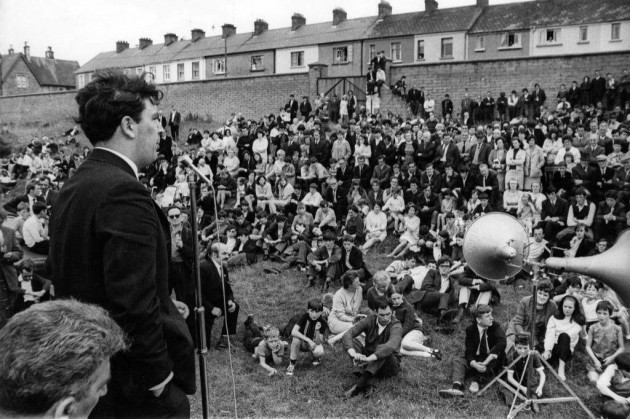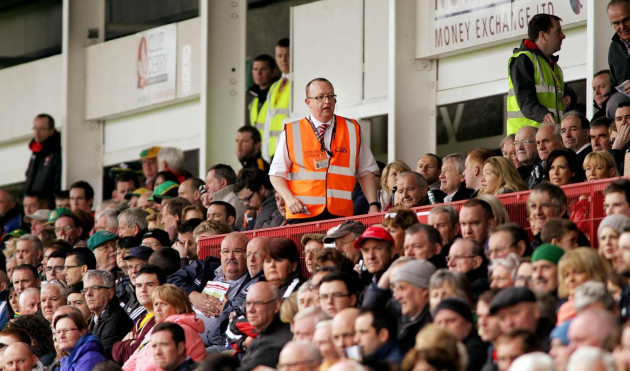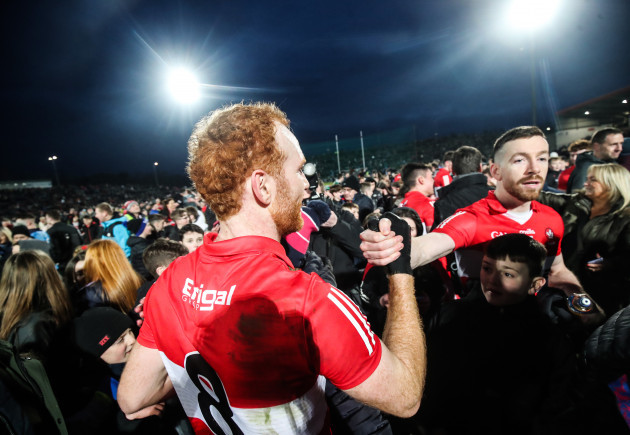LAST UPDATE | 29 Feb
ON SATURDAY NIGHT, the main attraction for sporting viewing is Celtic Park, with Derry and Dublin duking it out in a battle at the top of Division 1.
Twenty-five years on from when it was officially re-opened and established as Derry’s flagship ground, the city venue has seen it all in its transformation from wasteground to the regularly-packed fortress right now.
Fifty years ago, the principal use of some bare acres was as a meeting place where the likes of John Hume addressed the local citizens as they navigated a terrible path. Such was the day-to-day strife that diversion and sport were impossible.
Even after re-opening in late 1989, it has had an odd relationship with the county fanbase.
The success of the senior football team under Eamonn Coleman meant the crowds flocked to Celtic Park in the early ‘90s.
Then came stagnation. The supporters’ enthusiasm was dulled. An explanation sprung up that Celtic Park was too far away from the established heartlands of Gaelic football in south Derry.
It might only have been 30 miles away from say, Maghera, but the Glenshane mountain between them was symbolic of the mindset.
The guardians of Celtic Park became used to this and kept going.
Former county board chairman Seamus McCloy – from Bellaghy in south Derry – had the foresight to give the city its place. In his final-ever speech in the role, he talked about Derry city being a North Sea of untapped resources. Keep the faith, and it would be repaid. Some day.
Last Sunday against Galway, four players from the city-based Brian Óg Steelstown club played for Derry. That has never happened before in their history.
The very idea of a Celtic Park is an act of defiance from Derry Gaels. Not only was the entire area battling a system of gerrymandering from their political overlords, but opposition came from within.
Bishop Dr Neil Farren might have championed Derry on many fronts, campaigning for a University and becoming President of St Columb’s College at just 35, but he had an aversion to Gaelic Games and instructed parents to not join the likes of Eddie McAteer going door to door to collect money for a Celtic Park, and instead encourage their children to play soccer.
A few families kept the faith: Tommy Mellon, who the main stand is named after, and his family; Barney McFadden and family, and Sean Bradley were prominent.
Internment arrived in the late summer of 1971. Bloody Sunday occurred in late January 1972.
For a decade, Damien McKane was the Event Controller at the Park.
The most famous of all Derry walls is the one that bears the message: ‘You are now entering free Derry.’ Damien was born in the back room of that house. It was called Kitty Kane’s Wall where men would assemble to discuss the events of the day and play handball against the smooth surface.
He spent the first few years of his life there with his father John, mother Anne, and his grandparents.
“My dad was a freelance photographer and he was there when the shooting started (on Bloody Sunday)” says McKane.
“Once the shooting stopped, he returned and came back to the house with the ‘Derry Civil Rights Association’ banner in a plastic bag covered in blood.”
The blood belonged to Barney McGuigan. He was a 41-year-old married father of six who was shot in the back as he tried to go to the aid of the dying Patrick Doherty. They wrapped his body in the banner, which now is on display at the Museum of Free Derry.
McKane recalls the present site of Celtic Park as being a field of rushes.
What changed was Sean Bradley being elected Derry’s youngest ever chairman in 1984. He was given an ultimatum by Croke Park to develop the ground or sell it.
At that time, Derry City had joined the League of Ireland and became an emotional symbol of pride in the city. So Celtic Park was made functional with banks cleared, concrete slab seats erected, and chicken wire surrrounding the pitch.
Further developments spruced the place up. Work began on the Tommy Mellon Stand after the 2008 county final and it was opened in time for the 2009 Ulster championship win over Monaghan.
By the standards of today, it is showing its age. There are no warm-up spaces, with some teams using Sean Dolans’ ground to limber up. The dressing rooms are far from what is expected nowadays and catering is hosted in some portakabins.
All of that can be fixed of course. What Celtic Park has, though, is soul. Maybe not always, but on Saturday nights with a sharp wind whipping in from the Foyle River and an area drenched in history, it can be intoxicating.
“The people who come to the games now are different. It’s a lot more family-orientated. More females. Higher expectations,” says McKane.
“The days of turning up and expecting no more than a seat and a cup of tea if you are lucky is over. It has to be an experience.”
At the minute, a winning team is as good an experience as anything.
Derry right now are in the sweetest of sweet spots: top of the league with Mickey Harte slotting in seamlessly as manager.
The win on the opening night of the league over Kerry in Tralee was a statement. They beat Tyrone by six and walloped Monaghan and were the better side away to Galway.
Now Dublin are coming to town. The RTÉ cameras will be present.
On the PA, will be Sean Bradley, the man who started the rebuild.
Top billing on a Saturday night, in the town they love so well.




